Global Atomic Spectroscopy Market Forecast
- The approximately US$6.2 Bn market for atomic spectroscopy (2022) to reach US$9.6 Bn by 2030-end
- Market revenue likely to expand at a CAGR of 6.5% over the projection period 2023 - 2030
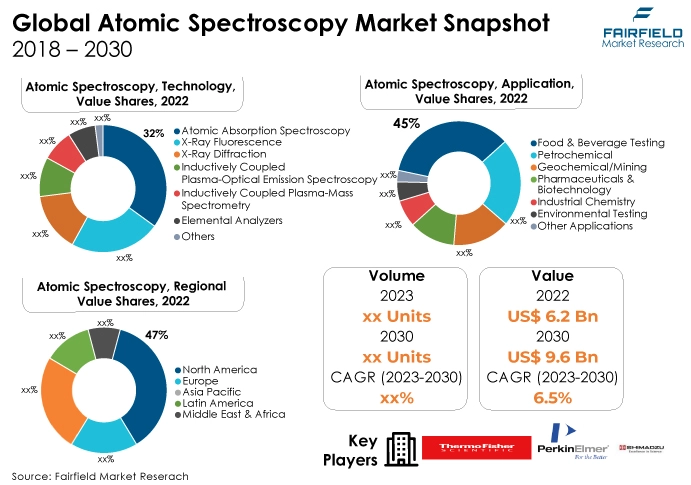
Quick Report Digest
- The key trend anticipated to fuel the growth of atomic spectroscopy is the increasing demand from the food industry.
- The atomic spectroscopy market is growing due to increasing applications in pharmaceuticals, environmental monitoring, and materials analysis. The need for precise elemental analysis, regulatory compliance, and stringent quality control is propelling market expansion.
- Growing food safety concerns are driving the atomic spectroscopy market by increasing the demand for precise elemental analysis. Atomic spectroscopy techniques are crucial for detecting contaminants like heavy metals, ensuring food safety, and compliance with stringent regulations, propelling the market growth.
- Atomic absorption spectroscopy (AAS) has secured the largest market share in the atomic spectroscopy market due to its versatility, reliability, and cost-effectiveness. AAS offers accurate elemental analysis, making it a preferred choice for industries requiring precise measurements, such as environmental monitoring, pharmaceuticals, and metals analysis.
- Pharmaceuticals and biotechnology hold the largest market share in the atomic spectroscopy market due to their critical need for precise elemental analysis. Atomic spectroscopy ensures pharmaceutical product quality, safety, and regulatory compliance, making it indispensable in these sectors.
- North America leads the atomic spectroscopy market due to its well-established industries, including pharmaceuticals, environmental testing, and research. Stringent regulations necessitate accurate elemental analysis, driving the demand for atomic spectroscopy instruments. The presence of key market competitors and advanced research further solidify its dominance.
- Asia-Pacific is experiencing the highest CAGR in the atomic spectroscopy market due to rapid industrialisation, expanding healthcare, and environmental concerns. Increasing investments in R&D, particularly in emerging economies like India and China, contribute to the region's robust growth in atomic spectroscopy applications.
- Regulatory compliance is challenging the atomic spectroscopy market as stringent requirements demand precise elemental analysis. Businesses must invest in advanced instruments and rigorous quality control, increasing operational costs. Non-compliance can result in fines and reputational damage, making it a significant challenge.
A Look Back and a Look Forward - Comparative Analysis
The atomic spectroscopy market was experiencing steady growth driven by increased demand for elemental analysis in various industries, including pharmaceuticals, environmental testing, and food safety.
Key players were focusing on technological advancements, such as mass spectrometry and ICP-MS, to enhance accuracy and sensitivity. The market was expected to continue its expansion due to the growing importance of trace element analysis and compliance with stringent regulations.
The market witnessed staggered growth during the historical period 2018 - 2022. This is due to the substantial growth of the major end-use application sectors, such as F&B testing and petrochemicals.
The petrochemical industry is driving growth in the atomic spectroscopy market due to its increasing need for precise elemental analysis and quality control in processes like petroleum refining and chemical production.
Atomic spectroscopy provides accurate measurements, ensuring product quality compliance with regulations and safety standards, hence its growing importance in the petrochemical sector.
The future of the atomic spectroscopy market appears promising, with continued growth expected. Factors driving this growth include advancements in analytical technologies, increasing applications in pharmaceuticals, environmental monitoring, and materials science, as well as rising demand for quality control and regulatory compliance.
The market's evolution will likely involve further automation, improved sensitivity, and expanded applications in various industries, solidifying its position as a vital analytical tool.
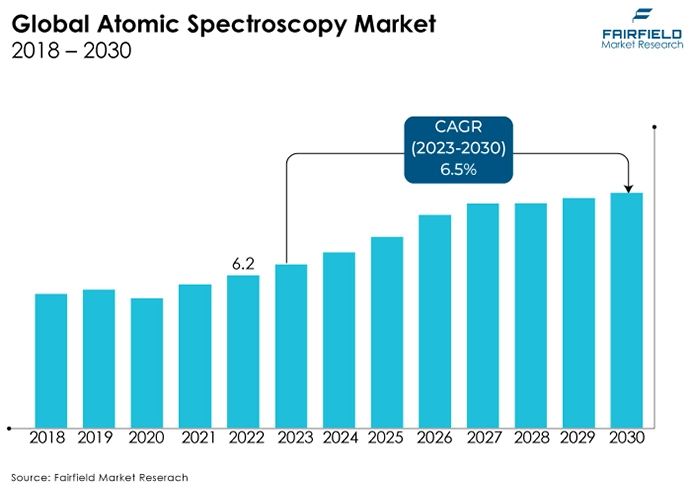
Key Growth Determinants
- Growing Food Safety Concerns
Growing food safety concerns are propelling the Atomic Spectroscopy Market as the need for accurate elemental analysis in food testing intensifies. Atomic spectroscopy techniques, like ICP-MS and ICP-OES, enable rapid detection of contaminants, heavy metals, and trace elements in food products, ensuring compliance with stringent regulations.
As global food supply chains expand, the demand for robust analytical solutions to guarantee food safety and quality continues to rise, driving the adoption of atomic spectroscopy in the food industry, including for detecting contaminants such as pesticides and additives.
- Increasing Government Investments
The atomic spectroscopy market is witnessing growth due to increasing government investments in technology development and research. Governments worldwide recognise the significance of atomic spectroscopy in various sectors like environmental monitoring, healthcare, and materials analysis. These investments support innovation, leading to the creation of more advanced and sensitive instruments.
Consequently, businesses and industries benefit from enhanced analytical capabilities, driving market expansion. Government backing also encourages the adoption of atomic spectroscopy for regulatory compliance and addressing emerging challenges, solidifying its role in modern analytical sciences.
- Rising Demand in Drug Safety Process and Medical Research
Atomic spectroscopy plays a vital role in drug safety and medical research, propelling the atomic spectroscopy market. It enables precise elemental analysis of pharmaceuticals, ensuring product quality and safety by detecting trace contaminants.
In medical research, atomic spectroscopy assists in biomarker discovery and understanding of disease mechanisms. As drug development and medical research advance, the demand for atomic spectroscopy tools increases, driving innovation in the field. This technology's ability to contribute to drug safety and medical breakthroughs reinforces its significance, fostering market growth.
Major Growth Barriers
- Lack of Skilled Professionals
The atomic spectroscopy market faces challenges due to a need for more skilled professionals proficient in operating and maintaining sophisticated analytical instruments. The complexity of atomic spectroscopy techniques, such as ICP-MS, and ICP-OES, demands specialised knowledge and expertise.
The need for more skilled personnel hampers the adoption and efficient utilisation of these technologies in various industries. To address this challenge, companies and educational institutions must invest in training programs and initiatives to cultivate a workforce capable of harnessing the full potential of atomic spectroscopy, thereby driving its market growth.
- Regulatory Compliance
Regulatory compliance poses challenges for the atomic spectroscopy market. Stringent regulations in industries like pharmaceuticals, environmental monitoring, and food safety require precise and accurate elemental analysis. Meeting these standards demands continuous instrument calibration, validation, and adherence to specific protocols.
Compliance-related paperwork and documentation can be time-consuming. Companies must invest in quality control measures and regularly update their instruments to ensure compliance, increasing operational costs.
Key Trends and Opportunities to Look at
- Growing Demand for Miniaturisation, and Portability
Miniaturisation and portability technology trends in the Atomic Spectroscopy Market involve the development of smaller, more portable spectroscopy instruments. This allows for on-site analysis and field applications, benefiting industries like environmental monitoring, mining, and more.
Compact devices offer convenience, mobility, and real-time results, making them increasingly valuable for applications requiring quick, in-field elemental analysis while reducing the need for centralised laboratory testing.
- Hyphenated Techniques
Hyphenated techniques in the atomic spectroscopy market involve combining atomic spectroscopy with other analytical methods, such as mass spectrometry or chromatography. These integrated approaches enhance analytical capabilities, offering improved selectivity and sensitivity.
Hyphenated techniques enable researchers and analysts to tackle complex sample matrices, identify trace elements, and provide more comprehensive insights into various industries, including environmental monitoring, pharmaceuticals, and materials analysis.
- Nanotechnology Applications
Nanotechnology applications in the atomic spectroscopy market involve using atomic spectroscopy techniques to characterise nanoparticles and nanomaterials with precision. These methods play a crucial role in quality control and research related to nanotechnology, enabling the accurate analysis of particle size, composition, and distribution.
Atomic spectroscopy contributes to advancing nanomaterial development and ensuring their safety and effectiveness in various industries, including electronics, medicine, and materials science.
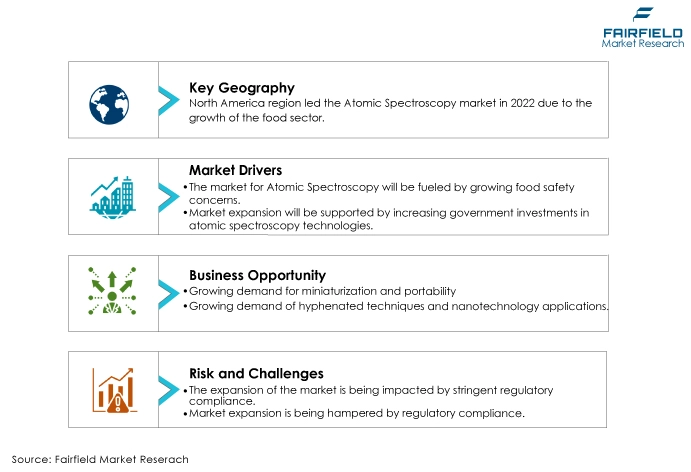
How Does the Regulatory Scenario Shape this Industry?
The regulatory scenario significantly influences the atomic spectroscopy market. Stringent regulations in industries like pharmaceuticals, environmental monitoring, food safety, and more require precise elemental analysis for compliance and quality control.
Atomic spectroscopy techniques are essential for meeting these regulatory requirements, ensuring product safety and adherence to environmental standards.
The demand for atomic spectroscopy instruments and services is driven by the need to detect and quantify elements, including heavy metals and contaminants, at trace levels. Failure to comply with regulations can result in fines, product recalls, and reputational damage, making regulatory compliance a top priority for businesses.
As regulations evolve and become more stringent, the atomic spectroscopy market responds with innovations in instrument technology, software, and analytical methodologies to help industries meet these challenges effectively.
Fairfield’s Ranking Board
Top Segments
- AAS Technology Retains Dominance
Atomic absorption spectroscopy (AAS) captured the largest market share in the atomic spectroscopy market due to its versatility and established track record. AAS offers precise elemental analysis across a wide range of applications, including environmental testing, pharmaceuticals, food safety, and metallurgy. Its reputation for accuracy, ease of use, and cost-effectiveness has made it a preferred choice for many industries.
Additionally, AAS can detect specific elements at trace levels, which is crucial for regulatory compliance. While other techniques like ICP-MS and ICP-OES offer advantages, AAS remains a staple method due to its reliability, simplicity, and compatibility with a variety of sample matrices.
Inductively coupled plasma-mass spectrometry (ICP-MS) is likely to be experiencing the highest CAGR through 2030, owing to its exceptional sensitivity and versatility.
ICP-MS can detect and quantify a wide range of elements at ultra-low concentrations, making it ideal for applications such as environmental analysis, pharmaceutical research, and geological exploration. Its ability to handle complex sample matrices, offer high throughput, and provide isotopic information has driven its adoption in diverse industries.
As the demand for trace element analysis and regulatory compliance grows, ICP-MS continues to expand its market presence, driving its high CAGR.
- Application in Pharmaceuticals & Biotechnology to Surge Ahead
Pharmaceuticals and biotechnology have captured the largest market share in the atomic spectroscopy market due to their critical need for precise elemental analysis. Atomic spectroscopy techniques like ICP-MS and ICP-OES play a pivotal role in drug development, ensuring the quality, safety, and efficacy of pharmaceutical products.
Additionally, these techniques are essential for compliance with stringent regulatory requirements, making them indispensable tools for the industry. As pharmaceutical research and production continue to expand, the demand for atomic spectroscopy instruments and services in this sector remains robust, contributing to its largest market share.
The environmental testing application will be experiencing the highest CAGR in the atomic spectroscopy market due to increasing environmental concerns and regulations. Atomic spectroscopy methods, such as ICP-MS and ICP-OES, provide the capability to detect and quantify trace elements and contaminants in soil, water, and air samples accurately.
The growing awareness of sustainability and the need for pollution control continue to drive the CAGR of atomic spectroscopy in the environmental testing sector.
Regional Frontrunners
North America Contributes the Largest Revenue Share
North America captured the largest market share in the atomic spectroscopy market due to several factors. The region is home to a well-established and technologically advanced industrial sector, including pharmaceuticals, biotechnology, environmental testing, and petrochemicals, which are major users of atomic spectroscopy technologies.
Stringent regulatory requirements in North America, particularly in the US, necessitate accurate elemental analysis, driving the demand for atomic spectroscopy instruments and services for compliance and quality control.
A robust research and development ecosystem and significant investments in scientific research and healthcare contribute to the growth of atomic spectroscopy applications in the region. The presence of key market players and a high level of awareness and adoption of advanced analytical techniques further bolster North America's dominance in the atomic spectroscopy market.
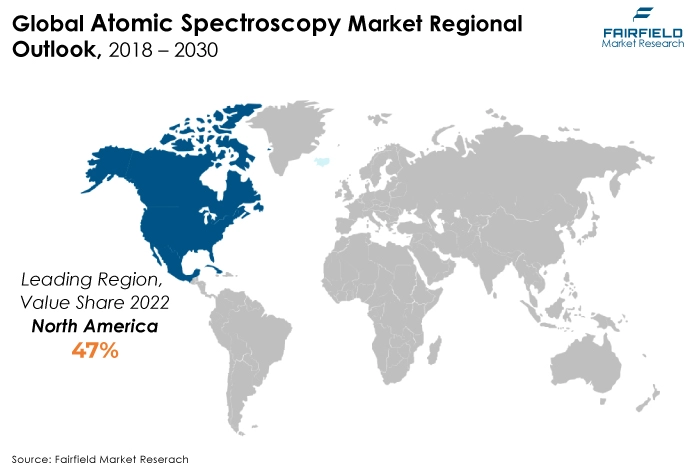
Asia Pacific Awaits an Influx of Opportunities
Rapid industrialisation, expanding pharmaceutical and biotechnology sectors, and increased environmental concerns are driving the demand for precise elemental analysis in the region. Additionally, growing investments in research and development, along with a burgeoning healthcare industry, are fuelling the adoption of atomic spectroscopy technologies.
The presence of emerging economies, such as India, and China, with expanding laboratory infrastructure and rising awareness of advanced analytical techniques, further contributes to the region's robust CAGR in the atomic spectroscopy market.
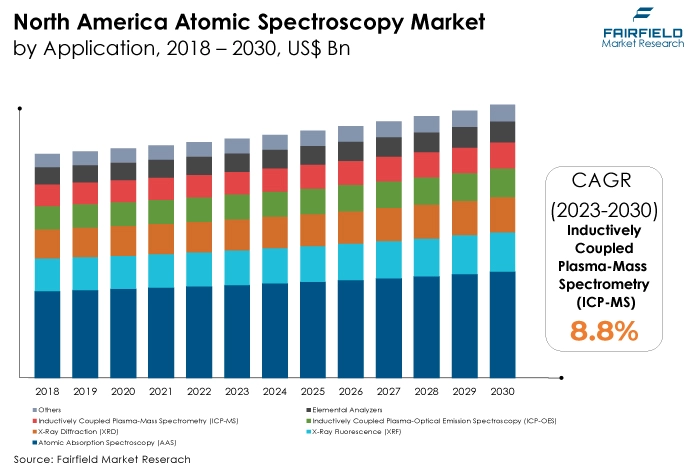
Fairfield’s Competitive Landscape Analysis
The global atomic spectroscopy market is consolidated, with fewer major players present globally. The key players are introducing new products and working on the distribution channels to enhance their worldwide presence. Moreover, Fairfield Market Research expects more consolidation over the coming years.
Who are the Leaders in the Global Atomic Spectroscopy space?
- Thermo Fisher Scientific
- PerkinElmer
- PerkinElmer
- Shimadzu Corporation
- Bruker Corporation
- Hitachi High-Tech Corporation
- GBC Scientific Equipment
- Rigaku Corporation
- Horiba Ltd.
- Teledyne Leeman Labs
- Analyticon Instruments Corporation
- Skyray Instrument Inc.
- Aurora Biomed Inc.
- Avantes BV
- Beijing Beifen-Ruili Analytical Instrument Co., Ltd.
Key Company Developments
New Product Launches
- March 2021: JASCO Corporation recently introduced the FP-8050 Series, a brand-new lineup of fluorescence spectrophotometers consisting of five distinct instruments. These instruments have been designed to encompass a comprehensive range of applications, spanning areas such as biological research, environmental analysis, chemical studies, and materials analysis.
- January 2021: Numares AG and Bruker Corporation have unveiled a collaborative agreement aimed at creating innovative diagnostic tests by leveraging the capabilities of NMR spectroscopy.
Distribution Agreement
- October 2020: Bruker Corporation has recently introduced the Fourier 80 system, a cutting-edge 80 MHz Fourier Transform Nuclear Magnetic Resonance (FT-NMR) benchtop spectrometer, within the European market.
From the Analyst's Perspective
Demand and Future Growth
Growth in the food industry is driving the market. The atomic spectroscopy market is experiencing strong demand driven by increasing applications in pharmaceuticals, environmental monitoring, and materials analysis.
The need for precise elemental analysis, regulatory compliance, and stringent quality control is propelling market growth. Emerging economies, technological advancements, and expanding R&D activities are further fuelling the market's future growth.
As industries continue to focus on trace element analysis and compliance with environmental regulations, the atomic spectroscopy market is poised for robust expansion in the coming years.
Supply Side of the Market
The major countries in the atomic spectroscopy market include the US, known for its leadership in pharmaceuticals, environmental testing, and cutting-edge research; China, experiencing rapid growth due to its expanding industrial and healthcare sectors; and Japan, renowned for technological advancements and research in atomic spectroscopy.
Germany, a key player in Europe with a strong focus on scientific research and industrial applications; and India, emerging as a significant market with a growing emphasis on analytical sciences and environmental testing. These countries represent pivotal regions contributing to the global atomic spectroscopy market's growth, innovation, and adoption.
In the atomic spectroscopy market, essential raw materials encompass spectroscopic standards, gases like argon for plasma-based techniques, high-purity solvents, reagents, and consumables such as nebulizers and torches. Prominent manufacturers of these raw materials include MilliporeSigma (formerly Sigma-Aldrich), and Merck KGaA, which produce spectroscopic standards and high-purity chemicals. Companies like Air Liquide are significant suppliers of specialty gases, including argon.
Additionally, various chemical suppliers worldwide offer a wide range of solvents, reagents, and consumables tailored to the specific needs of atomic spectroscopy applications, ensuring the availability of critical materials for the industry.
The Global Atomic Spectroscopy Market is Segmented as Below:
By Technology:
- Atomic Absorption Spectroscopy (AAS)
- X-Ray Fluorescence (XRF)
- X-Ray Diffraction (XRD)
- Inductively Coupled Plasma-Optical Emission Spectroscopy (ICP-OES)
- Inductively Coupled Plasma-Mass Spectrometry (ICP-MS)
- Elemental Analyzers
- Others
By Application:
- Food & Beverage Testing
- Petrochemical
- Geochemical/Mining
- Pharmaceuticals & Biotechnology
- Industrial Chemistry
- Environmental Testing
- Other Applications
By Geographic Coverage:
- North America
- The U.S.
- Canada
- Europe
- Germany
- U.K.
- France
- Italy
- Turkey
- Russia
- Rest of Europe
- Asia Pacific
- China
- Japan
- South Korea
- India
- Southeast Asia
- Rest of Asia Pacific
- Latin America
- Brazil
- Mexico
- Argentina
- Rest of Latin America
- Middle East & Africa
- GCC
- South Africa
- Egypt
- Nigeria
- Rest of the Middle East & Africa
1. Executive Summary
1.1. Global Atomic Spectroscopy Market Snapshot
1.2. Future Projections
1.3. Key Market Trends
1.4. Regional Snapshot, by Value, 2022
1.5. Analyst Recommendations
2. Market Overview
2.1. Market Definitions and Segmentations
2.2. Market Dynamics
2.2.1. Drivers
2.2.2. Restraints
2.2.3. Market Opportunities
2.3. Value Chain Analysis
2.4. Porter’s Five Forces Analysis
2.5. COVID-19 Impact Analysis
2.5.1. Supply
2.5.2. Demand
2.6. Impact of Ukraine-Russia Conflict
2.7. Economic Overview
2.7.1. World Economic Projections
2.8. PESTLE Analysis
3. Global Atomic Spectroscopy Market Outlook, 2018 - 2030
3.1. Global Atomic Spectroscopy Market Outlook, by Technology, Value (US$ Bn), 2018 - 2030
3.1.1. Key Highlights
3.1.1.1. Atomic Absorption Spectroscopy (AAS)
3.1.1.2. X-Ray Fluorescence (XRF)
3.1.1.3. X-Ray Diffraction (XRD)
3.1.1.4. Inductively Coupled Plasma-Optical Emission Spectroscopy (ICP-OES)
3.1.1.5. Inductively Coupled Plasma-Mass Spectrometry (ICP-MS)
3.1.1.6. Elemental Analyzers
3.1.1.7. Others
3.2. Global Atomic Spectroscopy Market Outlook, by Application, Value (US$ Bn), 2018 - 2030
3.2.1. Key Highlights
3.2.1.1. Food & Beverage Testing
3.2.1.2. Petrochemical
3.2.1.3. Geochemical/Mining
3.2.1.4. Pharmaceuticals & Biotechnology
3.2.1.5. Industrial Chemistry
3.2.1.6. Environmental Testing
3.2.1.7. Other Applications
3.3. Global Atomic Spectroscopy Market Outlook, by Region, Value (US$ Bn), 2018 - 2030
3.3.1. Key Highlights
3.3.1.1. North America
3.3.1.2. Europe
3.3.1.3. Asia Pacific
3.3.1.4. Latin America
3.3.1.5. Middle East & Africa
4. North America Atomic Spectroscopy Market Outlook, 2018 - 2030
4.1. North America Atomic Spectroscopy Market Outlook, by Technology, Value (US$ Bn), 2018 - 2030
4.1.1. Key Highlights
4.1.1.1. Atomic Absorption Spectroscopy (AAS)
4.1.1.2. X-Ray Fluorescence (XRF)
4.1.1.3. X-Ray Diffraction (XRD)
4.1.1.4. Inductively Coupled Plasma-Optical Emission Spectroscopy (ICP-OES)
4.1.1.5. Inductively Coupled Plasma-Mass Spectrometry (ICP-MS)
4.1.1.6. Elemental Analyzers
4.1.1.7. Others
4.2. North America Atomic Spectroscopy Market Outlook, by Application, Value (US$ Bn), 2018 - 2030
4.2.1. Key Highlights
4.2.1.1. Food & Beverage Testing
4.2.1.2. Petrochemical
4.2.1.3. Geochemical/Mining
4.2.1.4. Pharmaceuticals & Biotechnology
4.2.1.5. Industrial Chemistry
4.2.1.6. Environmental Testing
4.2.1.7. Other Applications
4.2.2. BPS Analysis/Market Attractiveness Analysis
4.3. North America Atomic Spectroscopy Market Outlook, by Country, Value (US$ Bn), 2018 - 2030
4.3.1. Key Highlights
4.3.1.1. U.S. Atomic Spectroscopy Market Technology, Value (US$ Bn), 2018 - 2030
4.3.1.2. U.S. Atomic Spectroscopy Market Application, Value (US$ Bn), 2018 - 2030
4.3.1.3. Canada Atomic Spectroscopy Market Technology, Value (US$ Bn), 2018 - 2030
4.3.1.4. Canada Atomic Spectroscopy Market Application, Value (US$ Bn), 2018 - 2030
4.3.2. BPS Analysis/Market Attractiveness Analysis
5. Europe Atomic Spectroscopy Market Outlook, 2018 - 2030
5.1. Europe Atomic Spectroscopy Market Outlook, by Technology, Value (US$ Bn), 2018 - 2030
5.1.1. Key Highlights
5.1.1.1. Atomic Absorption Spectroscopy (AAS)
5.1.1.2. X-Ray Fluorescence (XRF)
5.1.1.3. X-Ray Diffraction (XRD)
5.1.1.4. Inductively Coupled Plasma-Optical Emission Spectroscopy (ICP-OES)
5.1.1.5. Inductively Coupled Plasma-Mass Spectrometry (ICP-MS)
5.1.1.6. Elemental Analyzers
5.1.1.7. Others
5.2. Europe Atomic Spectroscopy Market Outlook, by Application, Value (US$ Bn), 2018 - 2030
5.2.1. Key Highlights
5.2.1.1. Food & Beverage Testing
5.2.1.2. Petrochemical
5.2.1.3. Geochemical/Mining
5.2.1.4. Pharmaceuticals & Biotechnology
5.2.1.5. Industrial Chemistry
5.2.1.6. Environmental Testing
5.2.1.7. Other Applications
5.2.2. BPS Analysis/Market Attractiveness Analysis
5.3. Europe Atomic Spectroscopy Market Outlook, by Country, Value (US$ Bn), 2018 - 2030
5.3.1. Key Highlights
5.3.1.1. Germany Atomic Spectroscopy Market Technology, Value (US$ Bn), 2018 - 2030
5.3.1.2. Germany Atomic Spectroscopy Market Application, Value (US$ Bn), 2018 - 2030
5.3.1.3. U.K. Atomic Spectroscopy Market Technology, Value (US$ Bn), 2018 - 2030
5.3.1.4. U.K. Atomic Spectroscopy Market Application, Value (US$ Bn), 2018 - 2030
5.3.1.5. France Atomic Spectroscopy Market Technology, Value (US$ Bn), 2018 - 2030
5.3.1.6. France Atomic Spectroscopy Market Application, Value (US$ Bn), 2018 - 2030
5.3.1.7. Italy Atomic Spectroscopy Market Technology, Value (US$ Bn), 2018 - 2030
5.3.1.8. Italy Atomic Spectroscopy Market Application, Value (US$ Bn), 2018 - 2030
5.3.1.9. Turkey Atomic Spectroscopy Market Technology, Value (US$ Bn), 2018 - 2030
5.3.1.10. Turkey Atomic Spectroscopy Market Application, Value (US$ Bn), 2018 - 2030
5.3.1.11. Russia Atomic Spectroscopy Market Technology, Value (US$ Bn), 2018 - 2030
5.3.1.12. Russia Atomic Spectroscopy Market Application, Value (US$ Bn), 2018 - 2030
5.3.1.13. Rest of Europe Atomic Spectroscopy Market Technology, Value (US$ Bn), 2018 - 2030
5.3.1.14. Rest of Europe Atomic Spectroscopy Market Application, Value (US$ Bn), 2018 - 2030
5.3.2. BPS Analysis/Market Attractiveness Analysis
6. Asia Pacific Atomic Spectroscopy Market Outlook, 2018 - 2030
6.1. Asia Pacific Atomic Spectroscopy Market Outlook, by Technology, Value (US$ Bn), 2018 - 2030
6.1.1. Key Highlights
6.1.1.1. Atomic Absorption Spectroscopy (AAS)
6.1.1.2. X-Ray Fluorescence (XRF)
6.1.1.3. X-Ray Diffraction (XRD)
6.1.1.4. Inductively Coupled Plasma-Optical Emission Spectroscopy (ICP-OES)
6.1.1.5. Inductively Coupled Plasma-Mass Spectrometry (ICP-MS)
6.1.1.6. Elemental Analyzers
6.1.1.7. Others
6.2. Asia Pacific Atomic Spectroscopy Market Outlook, by Application, Value (US$ Bn), 2018 - 2030
6.2.1. Key Highlights
6.2.1.1. Food & Beverage Testing
6.2.1.2. Petrochemical
6.2.1.3. Geochemical/Mining
6.2.1.4. Pharmaceuticals & Biotechnology
6.2.1.5. Industrial Chemistry
6.2.1.6. Environmental Testing
6.2.1.7. Other Applications
6.2.2. BPS Analysis/Market Attractiveness Analysis
6.3. Asia Pacific Atomic Spectroscopy Market Outlook, by Country, Value (US$ Bn), 2018 - 2030
6.3.1. Key Highlights
6.3.1.1. China Atomic Spectroscopy Market Technology, Value (US$ Bn), 2018 - 2030
6.3.1.2. China Atomic Spectroscopy Market by Application, Value (US$ Bn), 2018 - 2030
6.3.1.3. Japan Atomic Spectroscopy Market Technology, Value (US$ Bn), 2018 - 2030
6.3.1.4. Japan Atomic Spectroscopy Market Application, Value (US$ Bn), 2018 - 2030
6.3.1.5. South Korea Atomic Spectroscopy Market Technology, Value (US$ Bn), 2018 - 2030
6.3.1.6. South Korea Atomic Spectroscopy Market Application, Value (US$ Bn), 2018 - 2030
6.3.1.7. India Atomic Spectroscopy Market Technology, Value (US$ Bn), 2018 - 2030
6.3.1.8. India Atomic Spectroscopy Market Application, Value (US$ Bn), 2018 - 2030
6.3.1.9. Southeast Asia Atomic Spectroscopy Market Technology, Value (US$ Bn), 2018 - 2030
6.3.1.10. Southeast Asia Atomic Spectroscopy Market Application, Value (US$ Bn), 2018 - 2030
6.3.1.11. Rest of Asia Pacific Atomic Spectroscopy Market Technology, Value (US$ Bn), 2018 - 2030
6.3.1.12. Rest of Asia Pacific Atomic Spectroscopy Market Application, Value (US$ Bn), 2018 - 2030
6.3.2. BPS Analysis/Market Attractiveness Analysis
7. Latin America Atomic Spectroscopy Market Outlook, 2018 - 2030
7.1. Latin America Atomic Spectroscopy Market Outlook, by Technology, Value (US$ Bn), 2018 - 2030
7.1.1. Key Highlights
7.1.1.1. Atomic Absorption Spectroscopy (AAS)
7.1.1.2. X-Ray Fluorescence (XRF)
7.1.1.3. X-Ray Diffraction (XRD)
7.1.1.4. Inductively Coupled Plasma-Optical Emission Spectroscopy (ICP-OES)
7.1.1.5. Inductively Coupled Plasma-Mass Spectrometry (ICP-MS)
7.1.1.6. Elemental Analyzers
7.1.1.7. Others
7.2. Latin America Atomic Spectroscopy Market Outlook, by Application, Value (US$ Bn), 2018 - 2030
7.2.1. Key Highlights
7.2.1.1. Food & Beverage Testing
7.2.1.2. Petrochemical
7.2.1.3. Geochemical/Mining
7.2.1.4. Pharmaceuticals & Biotechnology
7.2.1.5. Industrial Chemistry
7.2.1.6. Environmental Testing
7.2.1.7. Other Applications
7.2.2. BPS Analysis/Market Attractiveness Analysis
7.3. Latin America Atomic Spectroscopy Market Outlook, by Country, Value (US$ Bn), 2018 - 2030
7.3.1. Key Highlights
7.3.1.1. Brazil Atomic Spectroscopy Market Technology, Value (US$ Bn), 2018 - 2030
7.3.1.2. Brazil Atomic Spectroscopy Market Application, Value (US$ Bn), 2018 - 2030
7.3.1.3. Mexico Atomic Spectroscopy Market Technology, Value (US$ Bn), 2018 - 2030
7.3.1.4. Mexico Atomic Spectroscopy Market Application, Value (US$ Bn), 2018 - 2030
7.3.1.5. Argentina Atomic Spectroscopy Market Technology, Value (US$ Bn), 2018 - 2030
7.3.1.6. Argentina Atomic Spectroscopy Market Application, Value (US$ Bn), 2018 - 2030
7.3.1.7. Rest of Latin America Atomic Spectroscopy Market Technology, Value (US$ Bn), 2018 - 2030
7.3.1.8. Rest of Latin America Atomic Spectroscopy Market Application, Value (US$ Bn), 2018 - 2030
7.3.2. BPS Analysis/Market Attractiveness Analysis
8. Middle East & Africa Atomic Spectroscopy Market Outlook, 2018 - 2030
8.1. Middle East & Africa Atomic Spectroscopy Market Outlook, by Technology, Value (US$ Bn), 2018 - 2030
8.1.1. Key Highlights
8.1.1.1. Atomic Absorption Spectroscopy (AAS)
8.1.1.2. X-Ray Fluorescence (XRF)
8.1.1.3. X-Ray Diffraction (XRD)
8.1.1.4. Inductively Coupled Plasma-Optical Emission Spectroscopy (ICP-OES)
8.1.1.5. Inductively Coupled Plasma-Mass Spectrometry (ICP-MS)
8.1.1.6. Elemental Analyzers
8.1.1.7. Others
8.2. Middle East & Africa Atomic Spectroscopy Market Outlook, by Application, Value (US$ Bn), 2018 - 2030
8.2.1. Key Highlights
8.2.1.1. Food & Beverage Testing
8.2.1.2. Petrochemical
8.2.1.3. Geochemical/Mining
8.2.1.4. Pharmaceuticals & Biotechnology
8.2.1.5. Industrial Chemistry
8.2.1.6. Environmental Testing
8.2.1.7. Other Applications
8.2.2. BPS Analysis/Market Attractiveness Analysis
8.3. Middle East & Africa Atomic Spectroscopy Market Outlook, by Country, Value (US$ Bn), 2018 - 2030
8.3.1. Key Highlights
8.3.1.1. GCC Atomic Spectroscopy Market Technology, Value (US$ Bn), 2018 - 2030
8.3.1.2. GCC Atomic Spectroscopy Market Application, Value (US$ Bn), 2018 - 2030
8.3.1.3. South Africa Atomic Spectroscopy Market Technology, Value (US$ Bn), 2018 - 2030
8.3.1.4. South Africa Atomic Spectroscopy Market Application, Value (US$ Bn), 2018 - 2030
8.3.1.5. Egypt Atomic Spectroscopy Market Technology, Value (US$ Bn), 2018 - 2030
8.3.1.6. Egypt Atomic Spectroscopy Market Application, Value (US$ Bn), 2018 - 2030
8.3.1.7. Nigeria Atomic Spectroscopy Market Technology, Value (US$ Bn), 2018 - 2030
8.3.1.8. Nigeria Atomic Spectroscopy Market Application, Value (US$ Bn), 2018 - 2030
8.3.1.9. Rest of Middle East & Africa Atomic Spectroscopy Market Technology, Value (US$ Bn), 2018 - 2030
8.3.1.10. Rest of Middle East & Africa Atomic Spectroscopy Market Application, Value (US$ Bn), 2018 - 2030
8.3.2. BPS Analysis/Market Attractiveness Analysis
9. Competitive Landscape
9.1. Application vs Application Heatmap
9.2. Manufacturer vs Application Heatmap
9.3. Company Market Share Analysis, 2022
9.4. Competitive Dashboard
9.5. Company Profiles
9.5.1. Thermo Fisher Scientific
9.5.1.1. Company Overview
9.5.1.2. Product Portfolio
9.5.1.3. Financial Overview
9.5.1.4. Business Strategies and Development
9.5.2. PerkinElmer
9.5.2.1. Company Overview
9.5.2.2. Product Portfolio
9.5.2.3. Financial Overview
9.5.2.4. Business Strategies and Development
9.5.3. Agilent Technologies
9.5.3.1. Company Overview
9.5.3.2. Product Portfolio
9.5.3.3. Financial Overview
9.5.3.4. Business Strategies and Development
9.5.4. Shimadzu Corporation
9.5.4.1. Company Overview
9.5.4.2. Product Portfolio
9.5.4.3. Financial Overview
9.5.4.4. Business Strategies and Development
9.5.5. Bruker Corporation
9.5.5.1. Company Overview
9.5.5.2. Product Portfolio
9.5.5.3. Financial Overview
9.5.5.4. Business Strategies and Development
9.5.6. Hitachi High-Tech Corporation
9.5.6.1. Company Overview
9.5.6.2. Product Portfolio
9.5.6.3. Financial Overview
9.5.6.4. Business Strategies and Development
9.5.7. GBC Scientific Equipment
9.5.7.1. Company Overview
9.5.7.2. Product Portfolio
9.5.7.3. Financial Overview
9.5.7.4. Business Strategies and Development
9.5.8. Rigaku Corporation
9.5.8.1. Company Overview
9.5.8.2. Product Portfolio
9.5.8.3. Financial Overview
9.5.8.4. Business Strategies and Development
9.5.9. Horiba Ltd.
9.5.9.1. Company Overview
9.5.9.2. Product Portfolio
9.5.9.3. Financial Overview
9.5.9.4. Business Strategies and Development
9.5.10. Teledyne Leeman Labs
9.5.10.1. Company Overview
9.5.10.2. Product Portfolio
9.5.10.3. Financial Overview
9.5.10.4. Business Strategies and Development
9.5.11. Analyticon Instruments Corporation
9.5.11.1. Company Overview
9.5.11.2. Product Portfolio
9.5.11.3. Financial Overview
9.5.11.4. Business Strategies and Development
9.5.12. Skyray Instrument Inc.
9.5.12.1. Company Overview
9.5.12.2. Product Portfolio
9.5.12.3. Financial Overview
9.5.12.4. Business Strategies and Development
9.5.13. Aurora Biomed Inc.
9.5.13.1. Company Overview
9.5.13.2. Product Portfolio
9.5.13.3. Financial Overview
9.5.13.4. Business Strategies and Development
9.5.14. Avantes BV
9.5.14.1. Company Overview
9.5.14.2. Product Portfolio
9.5.14.3. Financial Overview
9.5.14.4. Business Strategies and Development
9.5.15. Beijing Beifen-Ruili Analytical Instrument Co., Ltd.
9.5.15.1. Company Overview
9.5.15.2. Product Portfolio
9.5.15.3. Financial Overview
9.5.15.4. Business Strategies and Development
10. Appendix
10.1. Research Methodology
10.2. Report Assumptions
10.3. Acronyms and Abbreviations
|
BASE YEAR |
HISTORICAL DATA |
FORECAST PERIOD |
UNITS |
|||
|
2022 |
|
2018 - 2022 |
2023 - 2030 |
Value: US$ Million |
||
|
REPORT FEATURES |
DETAILS |
|
Technology Coverage |
|
|
Application Coverage |
|
|
Geographical Coverage |
|
|
Leading Companies |
|
|
Report Highlights |
Key Market Indicators, Macro-micro economic impact analysis, Technological Roadmap, Key Trends, Driver, Restraints, and Future Opportunities & Revenue Pockets, Porter’s 5 Forces Analysis, Historical Trend (2019-2021), Market Estimates and Forecast, Market Dynamics, Industry Trends, Competition Landscape, Category, Region, Country wise Trends & Analysis, COVID-19 Impact Analysis (Demand and Supply Chain) |
